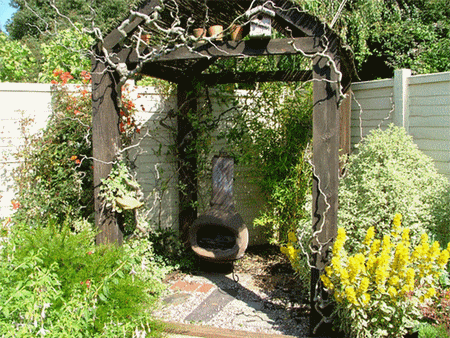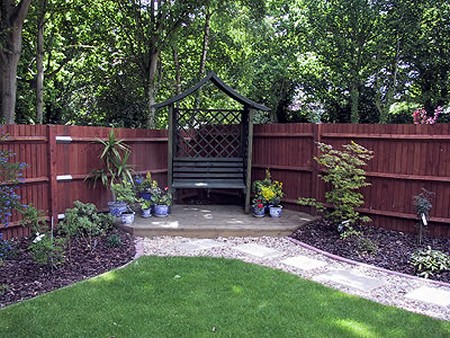Best Way to Get Color into a Shady Corner of the Garden
This planting design will suggest how you can get color into a shady corner of the garden. If tree roots look to be a big problem, cut them and sink a metal barrier to keep them from growing back into the area. Work up the soil and add humus, and, if you wish, fertilizer, too.
The plants I’ve suggested, all being herbaceous perennials, will die down to the roots each fall, so don’t expect to see anything in winter except perhaps some leaves on the foxgloves, which are biennial. If you want something with structure that will lend interest in winter, put a few shrubs at the back of the bed.
Consider this design a basic unit, which you can enlarge or reduce, as you wish. Some possibilities:
- Lengthen one of the twelve-foot sides to make a more irregular shape and plant the new area with more of the same perennials.
- Extend each of the straight sides a foot or two and bring the front curve forward. If that brings the bed out into sunshine, then you can edge it with attractively mounded plants that enjoy sun.
- A similar arrangement of the same plants but in greater numbers could be used for a straight border of anything up to twenty feet in length and about three feet wide.
- Among many shrubs that are tolerant of shade and therefore suitable for the rear of this bed are witch hazel, enkianthus, Pieris japonica, and mountain laurel (Kalmia latifolia) (don’t worry—that laurel takes years to grow to any size in the garden). In the rhododendron family, azaleas, either evergreen or deciduous, would provide a good background. Two of these, native to northeastern America and both deciduous, are the pink shell azalea (Rhododendron vaseyi) and swamp azalea (Rhododendron viscosum). Highbush blueberry (Vaccinium corymhosum) is another possibility.
- You can even put in an elegant little tree. “What!”—I hear you say— “Create more shade when I’ve just had to take trees out?” But those trees were big and old, with wicked roots and dense leaf canopy; these are small, almost shrublike, and will lend shape without giving much shade. I have put a Carolina snowbell (Halesia Carolina) in the corner but a dwarf Japanese maple would do as well.
Now for the herbaceous perennials. My choice is personal and arbitrary, but none of these plants is difficult to grow. I have chosen some for early bloom and some for late, while a few will bloom off and on throughout the summer.
I find white narcissus more effective in shade than yellow, and I prefer the flatcup varieties for their delicacy of form. I think the best of all is one of the very oldest, Narcissus poeticus ‘Actea’, similar to the old ‘Pheasant Eye’. It does well in damp shade and is exquisitely fragrant.
The blue flowers of perennial forget-me-not (Brunnera macrophylla) look delightful with the white narcissus, and after blooming the big heart-shaped leaves help to conceal the bulbs’ yellowing foliage.
For an equivalent spring scene on the other side of the bed, I suggest the traditional English bluebell (Scilla nonscripta). After bloom time, the fading foliage will be hidden by the vigorous plants around it.
Wild geranium (Geranium maculatum) is a bright pink species that looks light and lively in spring and has leaves that turn an attractive reddish color later in the season.
Lungwort (Pulmonaria) is a plant that does more than tolerate shade—it thrives in it. P. angustifolia, with blue flowers and dull green leaves, is the most commonly grown but cultivars of P. saccbarata, most with silver-splattered leaves, are especially lovely in light shade. Look for ‘Mrs. Moon’ (pink flowers) and ‘Sissinghurst White’.
Foxgloves (Digitalis purpurea) in white and rose shades are among the first of the tall spire plants of the season. Jacob’s ladder (Polemonium reptans) makes a carpet of soft blue beneath them.
There is nothing to stop you putting in a big old-fashioned bleeding heart (Dicentra spectabilis) in a shade border. Just remember that it dries up, browns, and goes dormant for the summer, leaving a large hole. This is why D. eximia is a much better choice for this bed. It has a smaller plant with attractive ferny foliage and it blooms intermittently through the summer. A number of named cultivars like ‘Bountiful’ and ‘Luxuriant’ give you choice of color.
There are hostas in any size you fancy; choose a small variety for the front, and go all out on a big-leafed one further back (you may be surprised at how much of the bed this can take up).
A low white astilbe (Astilbe arendsii ‘Bridal Veil’) will pair well with pink Dicentra eximia toward the front of the bed. A tall, late astilbe in a rose-purple shade (Astilbe taquetii ‘Superba’) will be a good companion for the blue lobelia (Lobelia siphilitica), which blooms later than the scarlet cardinal flower (L. cardinalis).
Put the bee balm (Monarda didyma) where it gets more light than the other plants; it will bloom but, without sunlight, none too generously. I suggest a light red such as ‘Cambridge Scarlet’. Near it, the tall white wands of snakeroot (Cimicifuga racemosa) will be in effective contrast.
For late summer, asters offer a wide choice but they present some problems in shade, so I have suggested only one, Aster novae-angliae ‘Alma Potschke’. If it’s not too shaded, its glowing rose-red flowers will more than repay you for the gamble.
Japanese anemone will be among the last to bloom, but its grapeleaf foliage will be handsome all summer. Anemone vitifolia ‘Robustissima’ is the easiest one of the tribe to grow, and usually comes into bloom safely ahead of the first frost.
Don’t forget hardy ferns, so useful for filling in when flowering perennials are resting, and ground covers such as wild ginger (Asarum canadensis) or Lamium ‘White Nancy’.
In the first year, while perennials are relatively small, you may have spaces to fill. No need to repeat here that, in general, annuals are not for shade. Among the few exceptions is impatiens, that good-natured plant that takes sun or shade. But rather than resorting to this and nothing else, slip in a few pansies, keeping to light colors, white and pale blue giving the best effect. Make your own experiments with any annuals that are said to tolerate shade, such as monkey flower (Mimulus) and wishbone flower (Torenia). If all else fails, drop in a potted tuberous begonia. All’s fair in a shady corner!
Categories
Advertisements
Recent Articles
 How to Understand Bed Sizes – A Small Guide
How to Understand Bed Sizes – A Small Guide How to Select Some Must Have Kitchen Accessories
How to Select Some Must Have Kitchen Accessories Best Way to Change a Car Tire
Best Way to Change a Car Tire Best Way to Write an Affirmation
Best Way to Write an Affirmation Best Way to Take Charge of Your Financial Life
Best Way to Take Charge of Your Financial Life Best Way to Survive a Party When You Don’t Know Anyone
Best Way to Survive a Party When You Don’t Know Anyone Best Way to Stop Self Sabotaging Yourself
Best Way to Stop Self Sabotaging Yourself Best Way to Start Journal Writing
Best Way to Start Journal Writing Best Way to Speak with a Powerful Voice
Best Way to Speak with a Powerful Voice Best Way to Simplify Your Life
Best Way to Simplify Your Life Best Way to Respond to a Put-Down
Best Way to Respond to a Put-Down Best Way to Reduce Acne Breakouts
Best Way to Reduce Acne Breakouts Best Way to Recover from Dining Disasters
Best Way to Recover from Dining Disasters Best Way to Quit Your Job Gracefully
Best Way to Quit Your Job Gracefully Best Way to Make Your Own Website
Best Way to Make Your Own Website




Leave a Reply